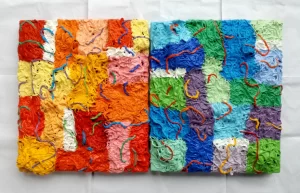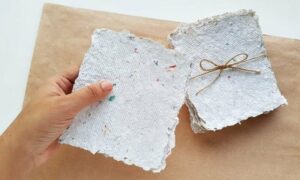Paper crafting is a diverse and intricate art form that transcends cultural boundaries, offering a window into the traditions and histories of different societies. It involves creating artistic pieces from paper, varying from folding and cutting to molding and layering. This exploration into global paper crafting styles unveils the richness of this art form, from the delicate folds of Japanese origami to the intricate cuts of German Scherenschnitte.
The Art of Paper Crafting
At its core, paper crafting is about transforming a simple sheet of paper into a work of art. Each culture has developed its techniques, influenced by historical, social, and environmental factors. This segment delves into how paper crafting is not just an art but a storytelling medium, reflecting the values, myths, and aesthetics of its origin.
Global Influence on Paper Crafting
Paper crafting is a global phenomenon, with each region imparting its unique flair to the craft. This section explores how these diverse styles have influenced and enriched the world of paper crafting, leading to a cross-pollination of techniques and designs.
Japanese Origami
Origami, the Japanese art of paper folding, is renowned for its precision and simplicity. This section explores the history of origami, tracing its evolution from a ceremonial and religious practice to a popular global art form.
History and Evolution of Origami
Origami’s roots are deep in Japanese culture, with its origins dating back to the 17th century. This subsection will explore how origami has evolved over the centuries, reflecting changes in Japanese society and aesthetics.
Popular Origami Designs
From the classic crane to complex modular designs, origami boasts an array of patterns. This subsection will highlight some of the most iconic origami designs and their significance in Japanese culture.
German Scherenschnitte
Scherenschnitte, the German art of paper cutting, involves creating intricate designs by cutting a single piece of paper. This section will delve into the history and cultural importance of Scherenschnitte in Germany.
The Tradition of Paper Cutting
This subsection explores the origins of Scherenschnitte and its evolution, showcasing how this art form has been a part of German tradition for centuries.
Scherenschnitte Techniques and Patterns
Scherenschnitte is known for its detailed and delicate patterns. This subsection will discuss the various techniques used in Scherenschnitte and showcase some traditional and contemporary patterns.
Mexican Papel Picado
Papel Picado is a traditional Mexican art form where intricate designs are cut into colorful paper sheets. This section explores the cultural significance of Papel Picado and its role in Mexican celebrations.
Cultural Significance of Papel Picado
Papel Picado is more than just decorative; it holds a deep cultural and spiritual significance in Mexican society. This subsection will explore the history and cultural meanings behind Papel Picado designs.
Crafting Techniques of Papel Picado
This subsection will describe the traditional methods used to create Papel Picado, highlighting the skill and precision required to craft these delicate paper designs.
Indian Paper Craft
Indian paper craft is rich and varied, encompassing a range of techniques and styles. This section will explore the historical and cultural background of paper craft in India.
Historical Background of Indian Paper Craft
This subsection will delve into the history of paper craft in India, exploring its origins and how it has evolved over time.
Unique Styles and Forms
Indian paper craft is known for its diversity and intricacy. This subsection will highlight some of the unique styles and forms of paper crafting found in India, from elaborate cuttings to ornate embossing.
Conclusion: The Diversity of Paper Crafting
The conclusion will summarize the journey through the world of global paper crafting styles, reflecting on the diversity and cultural significance of this art form. It will emphasize how paper crafting is a universal language of creativity and expression, bridging cultures and generations.
FAQs:
What is the historical significance of paper crafting in various cultures? Paper crafting has deep historical roots in many cultures, serving various purposes from ceremonial and religious to practical and decorative. In Japan, origami was initially used in religious ceremonies before becoming a popular art form. In Germany, Scherenschnitte has been a traditional folk art for centuries, reflecting regional stories and landscapes. In Mexico, Papel Picado is significant in celebrations like Day of the Dead, representing the fragility of life.
How does paper crafting vary between different countries? The variation in paper crafting between countries reflects their unique cultural, historical, and environmental influences. Japanese origami emphasizes precision and minimalism, often representing animals or natural elements. German Scherenschnitte focuses on intricate cutting techniques to create detailed scenes or patterns. Mexican Papel Picado involves cutting elaborate designs into colorful paper, often used for festive decorations. Indian paper craft includes a variety of techniques like cutting, folding, and embossing, showcasing elaborate designs and storytelling.
Can beginners participate in global paper crafting styles, and how? Yes, beginners can participate in global paper crafting styles. Many online resources, workshops, and kits are available to help beginners learn the basic techniques of origami, Scherenschnitte, Papel Picado, and other paper crafts. Starting with simple projects and progressively tackling more complex designs can build skill and confidence.
What materials are needed for starting paper crafting? The basic materials for starting paper crafting include paper, scissors, and a cutting mat. Specific crafts may require additional tools; for example, origami requires square paper, while Scherenschnitte might need specialized cutting tools like fine scissors or craft knives. For Papel Picado, thin, colored tissue paper and small chisels or punches are often used.
How does paper crafting benefit individuals and communities? Paper crafting offers numerous benefits, including enhancing fine motor skills, concentration, and creativity. It provides a therapeutic and meditative experience, reducing stress and promoting mindfulness. For communities, paper crafting can be a way to preserve cultural heritage, celebrate traditions, and bring people together through shared activities and festivals.


